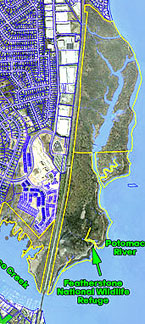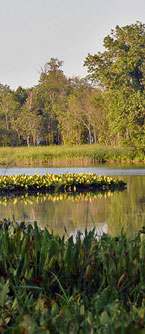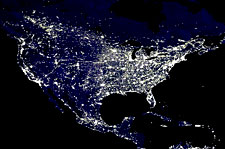IN THIS ISSUE |
|
Chesapeake Bay: After 27 years, EPA defines pollution limits for clean up |
When you have seen one ant, one bird, one tree, you have not seen them all. ~E.O. Wilson
|
Act Locally
PWCA stewardship programs are made possible thanks to the support of our members.
|
The Featherstone NWR is located along Prince William County's Potomac River shoreline between Neabsco Creek and the Occoquan River.
It is downstream from the Occoquan Bay NWR, upstream from Leesylvania State Park and directly across Occoquan Bay from Mason Neck National Wildlife Refuge.
The Featherstone Refuge is a critical link to Northern Virginia's network of riparian habitats that protect Bald Eagles and other wildlife communities.
Together, the Featherstone, Elizabeth Hartwell Mason Neck and Occoquan Bay National Wildlife Refuges make up the Potomac River National Wildlife Refuge Complex.
The Elizabeth Hartwell-Mason Neck and Occoquan Bay Refuges are both well visited and much studied by the public, and have evolved constituencies that recognize and value their critical importance to the natural character of Northern Virginia.
Featherstone, however, which adds yet another set of habitats – tidal wetlands and riparian forest in particular – lacks such a support system.
Human activities at Featherstone Refuge should be planned so that the sensitive, high quality vegetative and wildlife resources that make the Refuge unique are protected.
Allowing public access to the Featherstone Refuge would provide a much needed and unique area for nature enthusiasts in densely populated Northern Virginia, where public natural areas are limited and in demand.
It would also help stem undesirable uses which are impacting the refuge and generate, as it has at the other Refuges, a sense of community stewardship, enhancing efforts to protect the quality of natural areas.
 
|
|
Dark Skies - Saving the Nighttime Environment |

PWCA 1st Thursday Speaker Series
When: Thursday, January 6, 7:00 pm
Where: Bull Run Unitarian Universalist Church, 9350 Main Street, Manassas
Speaker: Milton Roney, International Dark Sky Association
Look up - can you see many stars? Can you even see the Milky Way?
If someone smeared red paint across the Mona Lisa, there's be an immediate response. The canvas of our night sky has been marred by urban light pollution, but the process was so gradual we hardly squawked.
Light by light, we are losing the night sky that is the source of inspiration, comfort and constancy to people throughout the world. The night sky is a national treasure that is now getting national attention.
This talk describes the components of light pollution - light trespass, glare, and sky glow - and the many ways they affect us. Bring your ideas and questions for a discussion about what can be done locally and nationally.
|
|
| Merrimac Farm Open House |
When: Sunday, January 16, 1:00 to 4:00 pm
Where: Stone House Visitor Center, Merrimac Farm, 15020 Deepwood Lane, Nokesville, directions
Stop by the Stone House to learn more about what's happening at Merrimac Farm and join us for a winter nature walk.
Expect light refreshments, good conversation and a refreshing walk led by local naturalists. No RSVP needed, bring your family and explore nature close to home.
|
|
Bird Survey - Broad Run Island at Innovation |
When: Saturday, Jan.22, at 8:00 am
Where: 9900 Sowder Village Sq., Manassas. Meet at the WEST end of the parking lot in the shopping center containing the Target.
Please join us for the first ever bird count at Broad Run Island in Bristow.
Until about 5 years ago, Broad Run Island was a pasture edged by trees and was periodically flooded. Today it is holds established wetlands created as a result of development within neighboring Innovation.
The island is connected to the natural features of Broad Run and neighboring forests and fields. Let’s explore what feather friends and other creatures may be making their winter homes in this new habitat.
Data collected may help secure grants for future restoration efforts associated with the Broad Run watershed. Anticipated time on the island is about one hour, so we'll also explore neighboring habitat as time permits. |
|
Monthly Bird Walk at Merrimac Farm |
When: Sunday, January 30, beginning at 8:00 am
Where: Merrimac Farm, North Parking Lot (1st entrance), 14710 Deepwood Lane, directions
Join us for the regularly scheduled last Sunday of the month bird walk at Merrimac Farm Wildlife Management Area. We'll travel through the uplands to the edge of the floodplain, covering a variety of habitats, including open fields and woodland edges. Everyone is welcome.
Dress for the weather, bring binoculars and cameras. More info and RSVP (not required) to PWCA , 703.499.4954 or [email protected].
|
|
Fish & Wildlife Service releases draft management plan for public comment
The draft management plan for the Featherstone National Wildlife Refuge was released this week.
This is the first step to opening the refuge to the public for wildlife-dependent recreation.
Click here for an electronic copy of the draft plan and click here to read more about the Featherstone Refuge.
The comment period is open to February 21 and two public meetings have been schedule.
Wednesday, February 2 from 2:00 to 4:00 pm and 6:30 to 8:30 pm. at Potomac Library, 2201 Opitz Blvd, Woodbridge
Thursday, February 3 from 6:30 to 8:30 pm at Bunston Elementary School, 10100 Gunston Rd, Lorton
Christmas Bird Count at the Featherstone Refuge
January 2 2011 -- It was a grey day, with tempaeratures in the high 40's and light rain on and off throughout the day. Five volunteers - Kevin Parker, Charles Smith, Jim Klakowicz, Ernie Sears and Kim Hosen - trekked through the Featherstone Refuge looking for birds as part of the Ft. Belvoir Circle for the 111th Christmas Bird Count.
We found 47 species of birds. Highlights include adult and immature Bald Eagles, Woodcock, a Barred Owl, Ruby-crowned Kinglets and Tundra Swan flying north along the Potomac River shoreline.
Click here to read the species list, click here to view photos of the day and click here to read more about the Christmas Bird Count, the oldest and largest citizen science event in existence.
|
|
|
| Nokesville Christmas Bird Count |
December 27 2010 --It was a tough day for birds and birders, cold with steady winds gusting to 30+ mph.
But despite the wind and mostly frozen ponds, 26 people sighted 87 species at the Nokesville CBC, a high count for the Nokeville CBC.
Highlights of the day include an immature Golden Eagle at MCB Quantico, and Brewer’s Blackbirds at a dairy farm on Fleetwood Drive, near the intersection with Aden Road.
Owls included a Great Horned Owl, Short-eared Owl on Parkgate Road, Eastern Screech Owl at Prince William Forest Park, and Barred Owls at MCB Quantico and Fauquier County. A Merlin was seen at the Rte. 234 Wetland Mitigation Area.
There was a Yellow-breasted Chat at the Kelly Leadership Center and a Ring-necked Pheasant was spotted near the Cedar Run Wetland Bank, likely escaped from a nearby hunting preserve.
We had just one Winter Wren, found at Merrimac Farm, and one Purple Finch, spotted in Fauquier County. American Tree Sparrows and a Meadowlark were at the Foggy Bottom Wetland Bank.
There were many White-throated Sparrows, especially in the wetland areas clustered near Cedar Run and MCB Quantico. Wilson’s Snipe were seen at two locations and it was good to see Northern Bobwhite on the list after two years with none.
We had a great day. Many thanks to the people who make the Nokesville CBC a success:
Kurt Gaskill, Marc Ribaudo, Russ Taylor, Kevin Parker, Ron Hughes, Jake Hosen, Charles Smith, Alton Dick, David Dick, Tom Attanaro, Larry Meade, Julia Flanagan, Greg Justice, Catherine Pauls Kubo, Kevin Munroe, Judy Gallagher, Phil Silas, Gary Myers, Lucy Uncu, Tim Stamps, Charlie Grymes, Cliff Pitts, Eli Hosen, Nancy Vehrs, Harry Glasgow, Christine Learman, Amy Wilson, Joyce Andres and Ernie Sears.
Click here for the entire species list, click here to view photos of the day and here to read more about the Nokesville Christmas Bird Count. |
|
|
Chesapeake Bay: After 27 years, EPA defines pollution limits for clean up |
Chesapeake Bay water quality is impaired because water flowing off urban/suburban areas and farmland is carrying too much nitrogen, phosphorous, and sediment downstream.
The bay is not healthy; we have dramatically damaged the populations of blue crabs, oysters, striped bass… The sediment smothers oysters and clouds the water, killing underwater grasses and reducing food/habitat for aquatic life.
The nutrients (nitrogen and phosphorous) cause damage by triggering excessive growth of algae. When the algae finally decays underwater, oxygen is depleted and everything dies in “dead zones.”
The Bay can absorb some pollution, but we have overloaded its capacity to handle the three major pollutants.
To solve the problem (and bring the Bay into compliance with the Clean Water Act), the Environmental Protection Agency (EPA) has determined the Total Maximum Daily Load (TMDL) of nitrogen, phosphorous, and sediment that each state can send downstream to the bay.
The TMDL limits issued by EPA today establish a “pollution diet” that will require a 25% reduction in nitrogen, 24% reduction in phosphorus and 20% reduction in sediment.
In Prince William County, the main source of that pollution comes from stormwater than runs off our roads, parking lots, rooftops, and over-fertilized lawns.
According to Wetland Studies and Solutions, a local firm with expertise in stormwater management, Prince William County may have to spend roughly $20-25 million/year, perhaps $300-350 million over the next 15 years to implement Best Management Practices (BMP’s) that control excessive locally-generated stormwater pollution.
Current and future residents will pay a high price now for three decades of county officials who approved blast-the-landscape developments that destroyed small intermittent streams, damaged larger perennial streams, and replaced forests with pavement without requiring streamside buffers to minimize pollution running into our creeks. Keep reading... |
|
|
|